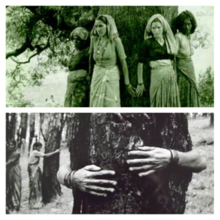45th anniversary of chipko movement

The Chipko movement was a non-violent agitation in 1973 that was aimed at protection and conservation of trees, but, perhaps, it is best remembered for the collective mobilisation of women for the cause of preserving forests, which also brought about a change in attitude regarding their own status in society. The uprising against the felling of trees and maintaining the ecological balance originated in Uttar Pradesh’s Chamoli district (now Uttarakhand) in 1973 and in no time spilled onto other states in north India. The name of the movement ‘chipko’ comes from the word ’embrace’, as the villagers hugged the trees and encirled them to prevent being hacked.
However, not many people know that the original Chipko andolan dates back to the 18th century and was started by Rajasthan’s Bishnoi community. The incident has been etched in the annals of history for the sacrifice of a group of villagers, who led by a lady named Amrita Devi, laid down their lives while protecting trees from being felled on the orders of then King of Jodhpur. After this incident, the king, in a royal decree, banned cutting of trees in all Bishnoi villages.
The trigger for the modern Chipko movement was the growth in development that Uttar Pradesh witnessed following the 1963 China border conflict. The need for infrastructural development attracted many foreign logging companies, who were eyeing the state’s vast forest resources. However, the forests were the lifeblood of the villagers and they relied on it for both food and fuel. In 1970, widespread floods inundated the area and was attributed to the mismanagement due to commercial logging.
The other reason that angered the villagers was the government’s policy that did not allow local agriculturists and herders to cut the trees for fuel wood or for fodder and for certain other purposes. However, a sports manufacturing company was given the permission to fell trees and use them to make equipment, which proved to be the final provocation and a people’s movement wasborn. It was then that environmentalist and Gandhian social activist Chandi Prasad Bhatt, founder of the cooperative organisation Dasholi Gram Swarajya Sangh, led the first Chipko movement near the village of Mandal in 1973.
When their appeals were denied, Bhatt led a group of villagers into the forest and embraced the trees to prevent logging. After many days of agitation, the government canceled the company’s logging permit. The Chipko movement can essentially be called a women’s movement. Women, being solely in charge of cultivation, livestock and children, suffered the most due to floods and landslides, caused due to rise in deforestation in the face of urbanisation.
The message of the Chipko workers made a direct appeal to them. They were able to perceive the link between their victimization and the denuding of mountain slopes by commercial interests. Thus, sheer survival made women support the movement. On its doodle blog in commemorating the 45th anniversary of the movement, Google wrote, “The Chipko Andolan also stands out as an eco-feminist movement. Women formed the nucleus of the movement, as the group most directly affected by the lack of firewood and drinking water caused by deforestation. The power of protest is an invaluable and powerful agent of social change.”
The Chipko Movement gained traction under Sunderlal Bahuguna, an eco activist, who spent his life persuading and educating the villagers to protest against the destruction of the forests and Himalayan mountains. It was his endeavor that saw then Prime Minister Indira Gandhi banning the cutting of tress. Bahuguna is best remembered for the slogan “ecology is the permanent economy”.